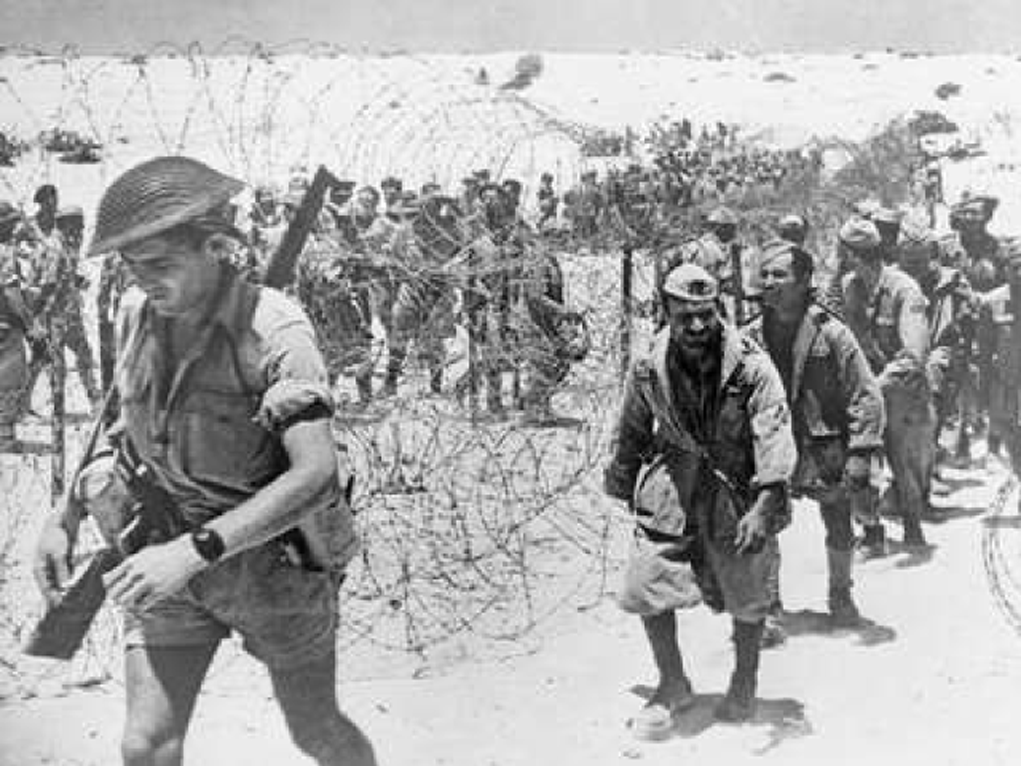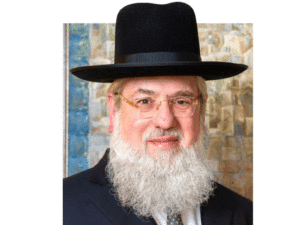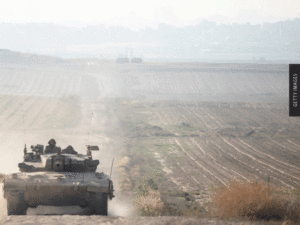How Eretz Yisroel Escaped Disaster During the Holocaust
In the summer of 1942, as Nazi General Erwin Rommel blazed through North Africa with the goal of overrunning the entire Middle East, terror swept the Yishuv.
Rommel’s very name triggered dread. His blitzkrieg victories in battle after battle created an aura of invincibility around him. He had just captured the vital British-held port of Tobruk in Libya, and drove the infamous Afrika Korps with its thousands of panzer tanks down the coast into Egypt. There he ousted British forces from a key city and headed toward El Alamein to attack other British positions.
Rommel was now poised to seize Alexandria where the British operated a large military base, as well as the British-controlled Suez Canal, which would have disrupted trade and supply links and greatly weakened Britain’s war effort.
The Nazi general, a brilliant and shrewd tactician nicknamed Desert Fox, seemed to be guided by an uncanny sense of his enemies’ plans. Each move of his was informed by up to date information on British positions, as if an inside source was feeding the Nazis all the Allies’ most top security secrets. Later in the war it would be discovered that this was exactly the case.
From Egypt, Rommel would have easy access to Eretz Yisroel and the oil rich and the strategically important Middle East. Soon, as summer arrived in the region, he was a day’s drive from Cairo and just a bit further from Palestine/Israel.
The Jews of Egypt and the Yishuv were in dire danger and knew it. Horrifying stories about Nazi atrocities had reached many of them and they had no illusions about what their fate would be under Nazi occupation. As the Battle of El Alamein broke out, panic gripped these communities. A half million Jews lived in Eretz Yisroel at the time, while 75,000 resided in Egypt.
In his memoir, Oheiv Yomim, quoted in Miracle at El Alamein, Yosef Tzvi Tchigel wrote of this period: “One day, when the Germans under their commander Rommel, may his name be erased, approached Egypt near Eretz Yisroel, I saw my father lying in bed in great anguish. A young boy of about twelve, I was very alarmed at the sight. He told me that the time had come for him to tell me a bitter fact—that the Germans were about to enter the Land and the Arabs had opened new factories for the manufacture of knives—they want to give the Germans a present when they arrive— with all the Jews slaughtered, chas vesholom.
“He said there might come a time when not many Jews would be left in the world and those who survived would have to continue our sacred mesorah, to spread Torah and faith.”
A woman who escaped Poland with her family shortly before the war recalled the mood in Eretz Yisroel at the time.
“At that time I lived in Eretz Yisroel which was under British control. The Jews learned that the mighty army of General Erwin Rommel was fast approaching their land. It is difficult to describe the terror that gripped us. Although we did not yet know of the gas chambers, hair-raising stories from survivors kept pouring in of the Nazis’ shocking brutality. How they murdered children, threw people into fire and committed indescribable atrocities.
“Those trying times, our family gathered to discuss the terrible news from the front and to debate what we could do. We were more frightened of falling alive into the Nazis’ hands than of death itself.
“…I looked up at the green tree against the blue sky and thought how beautiful life was. How bitter, I thought, to have to leave this beautiful world so young…” (Quoted in Zman, Vol. 1, cited in Miracle at El Alamein by R’ Zev Paretzky)
Einsatzkommandos Sent to the Middle East
Although the Yishuv did not know it then, an Einsatzkommando division– SS killing squad–had been organized in Berlin and flown to Egypt. It was headed by Walther Rauff, inventor of the gas van in 1941 that was used to murder Jews in Russia and Serbia. Rauff’s mission was to coordinate plans with Rommel for “special operations” – annihilation of the Jews of the Middle East —once Rommel had accomplished his objectives.
On July 20, 1942, Rauff flew to Tobruk, Libya, to meet with Rommel who instructed him to station his Einsatzkommandos in Athens until the moment was ripe for their deployment in the Middle East.
As Rommel moved closer to Eretz Yisroel, mysterious chalk marks appeared on Jewish houses overnight. Eventually it was discovered that the Arabs, anticipating Rommel’s arrival, had already staked their claims to Jewish property. R’ Chaskel Besser, a resident of the Yishuv, quoted in Miracle at El Alamein, recalled that “the streets were filled with Arabs who were fighting among themselves over who was going to get which Jewish house.”
In a November 28, 1941 meeting with Hitler, Haj Amin el-Husseini, the virulently Jew-hating Mufti of Jerusalem, told Hitler the Arabs felt great admiration for the Fuhrer, and that they were fighting the same three enemies, the Jews, the English and the Bolsheviks.
Haj Amin petitioned Hitler for permission to create a fully armed Arab legion that would fight alongside German forces. Hitler confirmed that Germany’s goal in the region included the destruction of the Jews living in Arab territory. He vowed to the Mufti that as soon as German forces reached the southern edge of the Caucasus, the Arab world would be liberated from both the Jews and the British.
So fervently did the Arabs believe in the coming German invasion of Palestine/Israel that in the summer of 1942, thousands of Arabs deserted Egyptian ranks with their weapons. They went into hiding, hoping to join Rommel’s troops after the German invasion, writes historian Klaus Mallman in Nazi Palestine: The Plans for the Extermination of the Jews of Palestine.
But in a stunning twist of events, the entire picture changed. British and Allied forces brought Rommel’s ruthless military campaign to a sudden halt at El Alamein. The Egyptian town and miles of surrounding desert then became the site of a series of ferocious battles over the next six months.
As the intense fighting played out, massive tank battles and nonstop shelling from fighter bombers pulverized entire brigades and ripped the desert apart, filling it with hundreds of thousands of corpses strewn among demolished tanks and guns.
Historians distinguish two key battles in this period; the First Battle of El Alamein that took place from June to mid-July, 1942, in which Rommel’s march toward Palestine was halted, and the Second Battle of El Alamein, that broke out in October and continued into November of that year.
The two battles were broken up by a two-month respite from August through September, as both sides called off attacks and focused on building up their supply lines for fuel, ammunition and reinforcements.
The second battle exceeded the first in bloodiness and casualties as the two sides alternately attacked and counterattacked, withdrew and advanced. Gradually, the British gained the upper hand.
When it was all over, the “invincible” Rommel had been decisively defeated.
The Tide of War Turns
El Alamein entered military legend as one of the seminal turning points in World War II where the tide of war turned in the Allies’ favor.
Historians have never fully explained this fascinating reversal. Some point to Hitler’s folly in attacking the Soviet Union, arguing that once he launched Operation Barbarossa in June 1942, Rommel’s force in North Africa was relegated to lower priority. That left “Desert Fox” with shortages of fuel, soldiers and ammunition.
Most of the Luftwaffe units in the Mediterranean were sent to Russia, which gave the British a freer hand in attacking Rommel’s supply convoys at sea and from the air, weakening Germany’s overall position in North Africa and setting the stage for Rommel’s ultimate defeat.
Others say the real reason Rommel failed was due to his hubris. Although short of fuel and ammunition, and lacking sufficient numbers of troops, the Nazi general persisted in his arrogant, grandiose expectations that his armies would triumph by sheer virtue of their superior fighting prowess and past war record.
As the tide turned against the Axis powers, the Allies continued to batter the German and Italian forces who had retreated to Tunisia. Finally, on May 12, 1943, the Axis leaders surrendered at Tunis with 270,000 troops. All were taken prisoner. The war in Africa had come to an end.
Back in Berlin, the heavily decorated and formerly admired Rommel fell out of favor with Hitler. He was suspected of having a hand in a failed conspiracy to assassinate the Fuhrer by setting off a bomb in his headquarters. Due to his popularity with the German public, he was given the option to commit suicide by swallowing cyanide or submit to a public trial followed by a prolonged public execution. He apparently chose the former, but was reported to have died of “a heart attack,” and was given a state funeral. The true facts about his death came to light after the war.
How The Yishuv Fought Back
In the two years before Rommel’s push toward Palestine, German, Italian and Vichy planes had bombed Tel Aviv and Haifa as part of an Axis effort to slow down the British war effort by hitting refineries.
Over 200 people were killed, but the raids swiftly faded after the war into little more than a footnote against the enormity of the European Holocaust.
In the same way, history has glossed over the plight of North African Jewry, including the hundreds that were killed by Nazi forces aided by local Arabs in Libya, Iraq and Tunisia, and the tens of thousands that were shipped to death camps and slave labor camps before these countries were liberated in 1943.
So too, the sustained outcry of tzadikei hador as the Nazis reached the gates of Eretz Yisroel and the terror that inspired even simple Jews to storm the heavens, has faded from collective memory.
In the aforementioned book, “Miracle at El Alamein,” Rabbi Zev Paretzky illuminates these forgotten moments with vignettes from various memoirs that capture a yishuv mobilizing against the Nazi threat with intense prayer, fasting and crying out to their Father in Heaven.
The poignant accounts excerpted below ring a special chord in these yemai ratzon.
‘I Can Still Recall Those Stormy Days…’
Rabbi Menachem Porush, a seventh generation Yerushalmi and longtime Agudas Yisroel leader, penned his memories of the period in Sharsheres Hadoros Betekufos Haso’aros:
“When the German army under Rommel stood at the gates of Eretz Yisroel, there was tremendous tension and indescribable anxiety. I can still recall those stormy days and the emotional gatherings for reciting Tehillilm. For three days and nights, people stood and recited Tehillim without pause, tears streaming.
“I remember the scene in the Yeshuos Yaakov shul in Meah Shearim where special prayers were arranged…I cannot forget the stirring sight of those who sat near me…Rav Mendel Gefner, one of the main organizers of the prayers, stood and said Tehillim as his tears wet the pages. On the other side stood Rav Shlomo Charis of Yerushalayim, praying in a voice quivering with emotion…. Prayers continued for three days and nights. They spoke in those days of many asifos of mekubalim who said special tefillos….”
The Gerer Rebbe in the Churva Shul
Rav Avraham Mordechai Alter, the Gerer Rebbe (the Imrei Emes) had arrived in Eretz Yisroel in 1940, with most of his family still in Nazi-occupied Poland. He was one of the driving forces behind a public asifah for tefillah that was held in the fall of 1942 in the Churva shul in the Old City.
Over 400 rabbonim came from all across the land to participate and a crowd of thousands spilled over into the courtyard.
The Agudas Yisroel weekly newspaper, Haderech, published an account of the event, quoted in Miracle at El Alamein, from which the following excerpts have been taken.
An atmosphere of gloom and mourning prevailed as the Rebbe, supported on one side by Chief Rabbi Rav Herzog and on the other by the Lev Simcha (the Rebbe’s son), ascended the steps to the aron kodesh.
“Eis tzara hi l’Yaakov umimena yivoshaya,” the Rebbe began. “It is a time of great trouble for Yaakov, yet he will be saved from it. The midrash explains that the gathering together of Yaakov and his sons is what saved them from the hands of Eisov. All of us must come together and unite! We must work together to do good deeds. We must awaken His mercy! Let us pray to Him to uproot evil from the world.
“We must keep ourselves strong and strengthen each other. The time will yet come when it will be very good for Yidden. We will merit to see consolation. Let us pray to Hashem for a complete redemption, speedily in our days.”
The rebbe then opened the aron Kodesh and the assemblage began to tearfully recite Tehillim.
Mekubalim Encircle the Land
In Olam Shel Chasid, cited by R’ Paretzky in Miracle at El Alamein, the author, Boruch Gefner, relates that beginning on the 15th of Tamuz, mishmaros were set up to recite Tehillim both day and night in the packed shtieblach of Meah Shearim. The author writes that the Brisker Rov ruled that the recital of Tehillim not pause for a moment.
At the same time, thousands gathered near the tziyun of the Ohr Hachaim on Har Hazeisim, whose yahrtzeit fell on that day. Prayer gatherings also took place at the tziyun of Shimon Hatzaddik in Yerushalayim, and at the tziyun of Rabi Shimon bar Yochai in Meron.
Days of fasting were designated and all work was suspended. Shuls were packed with throngs of Jews crying out to the heavens. Shofaoros were blown and tzedakah pledged. In some yeshivos, groups formed to study the laws of kiddush Hashem. Rav Shlomo Schreiber, the rosh yeshiva of Yeshiva Chayaei Olam, studied these halachos with his older students.
Rav Shmuel Hillel Shenker, a talmid of the Alter of Kelm and a son in law of Rav Yosef Chaim Sonnenfeld, is said to have taken with him ten of the known mekubalim of Yerushalayim and encircled the land from one end to the other while reciting prayers and holy Names, a Kabbalistic segulah for the Yishuv’s protection.
A memoir titled Ish Mibeis Lechem Yehuda; Hagaon Hamekubal Rav Yehuda Fetaya by Yishai Shaul recounts a similar incident around this time, in which a group of rabbonim persuaded the British air force to allow them to circle the borders of Eretz Yisroel in an air force plane.
According to the account, quoted by R’ Paretzky, a Sergeant Delaney piloted the plane that took the rabbonim on the flight. They traveled along the coast of Egypt and Eretz Yisroel, turned south at Alexndria until the southernmost point of the Suez Canal to Aqaba, and continued up the Jordan River to Yerushalayim.
The story was published in the Jerusalem Post on August 14, 1953. When the writer sought to verify the story’s authenticity, he was told it could be found in the memoirs of Rav Yehoshua Moshev, and that the rov who planned and organized the flight was Rav Yehuda Fetaya, a elderly renowned mekubal.
‘Weeping and Great Repentance’
Rav Meshulam Dovid Soloveitchik, a son of the Brisker Rov, quoted in Sod Hachashmal, recalled this period as a time of intense tefilla and teshuva:
“In Poland, during the summer before the outbreak of war, they said that all would be well, but in Yerushalayim, when the German army stood at El Alamein on their way to conquering Eretz Yisroel, people did not speak calming words. All the shuls were open day and night. There were continuous mishmaros of prayer, weeping and great repentance. Literally day and night there were cries heard in the shuls from men, women and children.
I remember that the Lutzker Rov, Rav Zalman Sorotozkin, got up on the bima in the midst of prayers and cried out: “V’af gam zos, beheyosom b’eretz oyveihem, lo me’astim velo ge’altim… (Vayikroh, 26:44). The posuk says “Even then, when [Bnei Yisroel] are in the lands of their enemies, I will not be disgusted by them and will not reject them to the point of destroying them…”
“If these wicked ones enter Eretz Yisroel,” Rav Sorotzkin cried out through his tears, “would this not be considered me’astim?! This would not be considered ge’altim!?
Shiva Asor B’Tamuz Fraught with Fear
A woman who lived in Eretz Yisroel during this period described the atmosphere, quoted in Zman, Vol 1.
“My father’s eyes filled with tears whenever he read the newspapers, but he insisted the fate of the Yishuv was not yet sealed. With prayer we could yet overturn the decree.
“But Rommel’s army was advancing with incredible speed. They covered twenty-five miles a day. In no time they arrived at outer forces once considered impenetrable. We hoped at the very least they would hold up the enemy and buy us time.
“Our hopes were ripped to shreds. The enemy overpowered even these defenses. This was right before the period of the Three Weeks and Jews all across Eretz Yisroel spent that Shiva Asor B’tamuz in fear, hoping for a miracle.
“We fasted and prayed. Every Jew I met that day was fasting, even those who long ago had abandoned religious practice, like the communists and members of Hashomer Hatzair. Thousands of Jews gathered in the shuls, weeping and pleading with Hashem to save them from the terrible fate awaiting us.
“This was the same day on the calendar that 2,000 years ago, the enemy had broken through the gates of Yerushalayim and began the churban. In our own day, a deadly enemy was once again poised to strike. But Hashem took pity on us.
Aseres Yemai Teshuva: ‘Not A Time For Complacency ‘
When Rommel was defeated in the First Battle of El Alamein in July 1942, Rav Zalman Sorotzkin delivered a drosha in which he warned his listeners that the danger was far from over, and that it was not a time for complacency. His comments were recorded in the Bais Yaakov Journal, no. 221
“Just as Rosh Hashanah is followed by Aseres Yemei Teshuva,” he said, “so too, when Hashem defeats our enemies for us, we should use this event to spur us to do teshuva, for who knows? It’s possible we have been granted only a temporary respite.”
The rov recalled the tearful suspense a few weeks earlier when Rommel’s armies were at their doorstep. “Hashem heard our voices and the enemy stopped in his tracks. Let us thank and bless Him for this chesed. But everyone agrees that the danger has not passed and we remain in suspense, hoping for Hashem’s mercies. We need to try to understand why the enemy has suddenly stopped his rampaging for a month…What does Hashem want from us during this respite?”
Rav Sorotzkin answered his question based on a drosha the Chasam Sofer delivered under similar circumstances, after Napoleon’s retreat from Pressburg in 1805.
“We are suspended in judgment just as in the Aseres Yemai Teshuva. Perhaps we have been given more time because our Yom Hadin is harsher than that of Yom Kippur. The enemy has decreed absolute destruction on us, chas vesholom. We must use these days of repentance far better than the Jews of Pressburg did. For their danger was caused by a king of chesed (Napolean) while over us hovers the threat of a king kosheh keHomon, as harsh as Homon.
*****
Suckered By Divine Providence
A new book, Shadow War, by Israeli historian Gershom Gorenberg, suggests a novel idea: Rommel’s downfall was due to a fluke of incompetence on the American side that was so bizarre it had to be an “an act of G-d.”
The author notes that in June 1942, a determined Rommel armed with formidable forces and a battle record of unbroken victory, set out on a major push to finally take over North Africa from the allies.
Divine Providence came into play, camouflaged as weird happenstance.
The British had been urgently warning the Americans to change the code in their military communications, after their discovery that the Germans had broken the code and for some time had been able to intercept and read all of Washington’s war communications.
On June 17, noted Gorenberg, Washington sent out word to its offices and officials around the world to change their “cipher,” an algorithm for performing encryption. But incomprehensibly, it took an entire week for these orders to be implemented. In the meantime, the compromised code was still being used by the Americans.
Before the cipher change went into effect, the British had planned to make their grand stand at a town called Mersa Matruh, a port city on Egypt’s Mediterranean coast. A U.S. military attaché in Cairo passed this information on to his superiors in Washington, a message that was intercepted and read by Rommel, who planned his own strategy accordingly.
But at the last minute, the commander of the British military’s Eighth Army, Gen. Claude Auchinleck, made a switch in plans. He decided to make his stand instead at El Alamein, not Mersa Matruh, where only a small British detachment would remain.
When Rommel, using old information no longer relevant, poured all his resources into capturing Mersa Matruh, he believed that he’d effectively won the North African campaign, clearing the way to the rest of the Middle East.
But as he moved his troops east, Rommel suddenly encountered fierce resistance at El Alamein from a British contingent he never expected and was ill prepared for.
“Rommel had stuck his fists in a thornbush and his forces were caught,” Gorenberg wrote.
If Rommel hadn’t received the report (prior to the U.S. code change) that the British were making their last stand at Mersa Matruh, he might have listened to his own intelligence officers advising him about British fortifications at El Alamein. Their reports suggested a possible shift in British battle strategy.
But because his intelligence source from the intercepted American code had always proved reliable, Rommel made a disastrous judgment call, trusting the (outdated) intelligence over the advice of his staff. And because the cipher change inexplicably took a week to become operative, information kept flowing from the old code as in the past, giving Rommel no reason to suspect anything was amiss while he primed his troops for an all-out attack on Mersa Matruh.
Having never discovered that the British plans had been altered, he was blindsided by the fierce resistance he met at El Alamein. The supreme irony of this situation, writes Gorenberg, is that far from being a ploy by the Allies, it was an intelligence failure on the part of the Americans that paradoxically worked in the Allies favor.
And that changed the course of the war.
Ultimately, thanks to this improbable chain of events, the Nazi general who inspired an almost mythical terror in his opponents was miraculously routed at El Alamein. The Axis campaign was effectively defeated, preventing the extermination of the Jews of North Africa and the Middle East.








